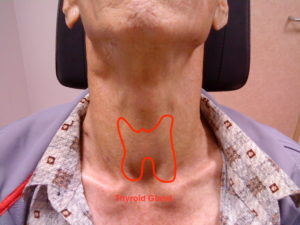Thyroid cancer
The thyroid gland is sited in the neck like a butterfly – wrapping itself around the windpipe. The word thyroid is derived from the Greek word thyros which means shield as it appears to protect the windpipe

Thyroid cancer is not uncommon. In Singapore the incidence has risen from 2.5 per 100,000 persons in 1974 to 5.6 per 100,000 in 2013. It is the eighth most common cancer.
What increases my risk of thyroid cancer?
The risk of thyroid cancer is higher in people who have a family member with this cancer. There’s also an increased risk in people who have had testicular, oesophageal and breast cancer and lymphoma. Radiotherapy to the neck also increases the risk of thyroid cancer.
Inflammation of the thyroid gland, a condition called thyroiditis. increases the risk of thyroid cancer.
How does thyroid cancer present?
Thyroid cancer often presents as a painless lump in the neck. This swelling may be fairly slowly growing. In aggressive thyroid cancers, the swelling may grow rapidly and cause hoarseness and difficulty breathing.
Unfortunately there is no cancer marker available that can diagnose people with early-stage thyroid cancers. Blood tests for thyroid hormone levels are not useful. Thyroid hormone levels are often normal in patients with thyroid cancer.
An ultrasound scan of the neck is a useful tool in diagnosing thyroid cancer. Unfortunately thyroid nodules are fairly common and may be present in up to 60% of patients. It is therefore difficult to identify which thyroid nodules may be a thyroid cancer.
Nodules that appear suspicious on an ultrasound scan are subjected to a needle biopsy. This is a simple procedure that can be undertaken in the clinic or in the radiology department.
A fine needle is passed into the thyroid nodule and a few cells are sampled for examination. Examination of the thyroid cells is called cytology and this is able to tell us even nodule is cancerous or not.
What is the treatment for thyroid cancer?
The primary treatment for thyroid cancer is removal of the thyroid gland. This is an operation called a thyroidectomy. Depending on the size of the thyroid cancer, partial removal of the thyroid gland may be an option.
When the thyroid cancer is large, or the nature of the cancer is aggressive, complete removal of the thyroid gland and any lymph nodes in the central neck is undertaken.  this is often followed with treatment with radioactive iodine.
Removal of the thyroid gland or thyroidectomy is a safe operation. Depending on the extent of surgery, this operation may take an hour or three hours. The risks of the surgery include bleeding following the operation, a low calcium level and hoarseness. In The ENT clinic, surgery on the thyroid gland is undertaken with nerve integrity monitoring. This ensures that the risk of hoarseness or any change in voice is minimized.
What are the outcomes of thyroid cancer following treatment?
Thyroid cancer is a relatively “good” cancer if there such a thing. In stage I-III of differentiated thyroid cancers, the overall survival approaches 99%.
However, it is important to seek the correct treatment from the beginning to ensure the best outcome. At The ENT Clinic, our surgeons – Dr Christopher Hobbs, Dr Annabelle Leong and Dr Jeeve Kanagalingam – work as a team to offer our patients the optimal care.
Share this blog via:
